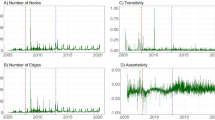Abstract
This paper analyses the European Emission Trading System (ETS) from a network perspective. It is shown that the network exhibits a strong core-periphery structure also reflected in the network formation process. Due to a lack of centralized market places, operators of installations which fall under the EU ETS regulations have to resort to local networks or financial intermediaries if they want to participate in the market. This undermines the central idea of the ETS to exploit marginal abatement costs.
Access this chapter
Tax calculation will be finalised at checkout
Purchases are for personal use only
Similar content being viewed by others
Notes
- 1.
Council Decision of 15 December 1993 [3].
- 2.
Noteworthy exceptions are the United States which signed but never ratified the KP and finally withdrew in 2001 and Canada which quit the treaty in 2011.
- 3.
Carbon dioxide, methane, nitrous oxide, sulphur hexafluoride, hydrofluorocarbons and perfluorocarbons.
- 4.
This is the marginal cost of reducing green house gas emissions by one unit.
- 5.
One emission allowance unit typically corresponds to one metric ton of \(\textit{CO}_2\)-equivalent.
- 6.
The majority of currently ongoing Joint Implementation projects are situated in transition economies with Annex 1 obligations like the Russian Federation and Ukraine [5].
- 7.
The directive was later amended by Directive 2004/101/EC, Directive 2008/101/EC, Regulation (EC) No 219/2009 and Directive 2009/29/EC.
- 8.
The in- and out-degrees of each agent: this means the active and passive connectedness of agents.
- 9.
Be the k-core of graph a maximal subgraph in which each vertex has at least degree k. The cliquishness or coreness of a vertex is then k if it belongs to the k-core but not to the (k+1)-core. [12].
- 10.
Eigenvector centrality: the first eigenvector of the adjacency matrix giving the centralities for each vertex. It can be understood as a reciprocal process in which the centrality of a vertex depends proportionally on the centralities of other vertices to which it is connected.
References
United Nations: Kyoto Protocol to the United Nations Framework Convention on Climate Change. http://unfccc.int/resource/docs/convkp/kpeng.pdf (1998)
United Nations: United Nations Framework on Climate Change. https://unfccc.int/files/essential_background/background_publications_htmlpdf/application/pdf/conveng.pdf (1992)
European Council: 94/69/EC: Council Decision of 15 December 1993 concerning the conclusion of the United Nations Framework Convention on Climate Change. http://eur-lex.europa.eu/legal-content/EN/TXT/?uri=CELEX:31994D0069 (1993)
Ellerman, D., Decaux, A.: Analysis of post-Kyoto CO2 emissions trading using marginal abatement curves. MIT Joint Program on the Science and Policy of Global Change (1998)
UNEP Risoe Centre: JI & CDM projects. http://www.cdmpipeline.org/ (1998)
Ellerman, A.: Pricing carbon: the European Union emissions trading scheme. Cambridge University Press (2010)
European Council: 2106th Council meeting ENVIRONMENT Luxembourg, 16–17 June 1998. http://europa.eu/rapid/press-release_PRES-98-205_en.pdf (1998)
European Parliament: Directive 2003/87/EC of the European Parliament and the Council of 13 October 2003 establishing a scheme for greenhouse gas emission allowance trading within the Community and amending Council Directive 96/61/EC. http://eur-lex.europa.eu/legal-content/EN/TXT/PDF/?uri=CELEX:02003L0087-20090625&from=EN (2003)
Ellerman, A., Joskow, P.: The European Union’s emissions trading system in perspective. Pew Center on Global Climate Change Arlington (2008)
Jaraite, J., Jong, T., Kazukauskas, A., Zaklan, A., Zeitlberger, A.: Ownership Links and Enhanced EUTL Dataset. European University Institute, Florence. http://fsr.eui.eu/CPRU/EUTLTransactionData.aspx (2013)
Li, D., Schürhoff, N.: Dealer networks. SSRN paper 2023201 (2014)
Seidman, S.: Network structure and minimum degree. Soc. Netw. 5, 269–287 (1983)
Boyd, P., et al.: Computing continuous core/periphery structures for social relations data with MINRES/SVD. Soc. Netw. 32, 125–137 (2010)
Maslov, S., Sneppen, K.: Specificity and stability in topology of protein networks. Science 296, 910–913 (2002)
Butts, C. et al.: Introduction to Exponential-family Random Graph (ERG or p*) modeling with ergm. http://cran.r-project.org/web/packages/ergm/vignettes/ergm.pdf (2014)
Ellerman, D., Buchner, B.: The European Union emissions trading scheme: origins, allocation, and early results. Rev. Environ. Econ. Policy 1(1), 66–87 (2007)
Schreurs, M., Tiberghien, Y.: Multi-level reinforcement: explaining European Union leadership in climate change mitigation. Glob. Environ. Politics 7(4), 19–46 (2007)
Freeman, L.C.: Centrality in social networks I: conceptual clarification. Soc. Netw. 1, 215–239 (1979)
Acknowledgments
The authors acknowledge the support of the EU FP7 FET project SIMPOL.
Author information
Authors and Affiliations
Corresponding authors
Editor information
Editors and Affiliations
Rights and permissions
Copyright information
© 2016 Springer International Publishing Switzerland
About this paper
Cite this paper
Karpf, A., Mandel, A., Battiston, S. (2016). A Network-Based Analysis of the European Emission Market. In: Battiston, S., De Pellegrini, F., Caldarelli, G., Merelli, E. (eds) Proceedings of ECCS 2014. Springer Proceedings in Complexity. Springer, Cham. https://doi.org/10.1007/978-3-319-29228-1_24
Download citation
DOI: https://doi.org/10.1007/978-3-319-29228-1_24
Published:
Publisher Name: Springer, Cham
Print ISBN: 978-3-319-29226-7
Online ISBN: 978-3-319-29228-1
eBook Packages: Physics and AstronomyPhysics and Astronomy (R0)




